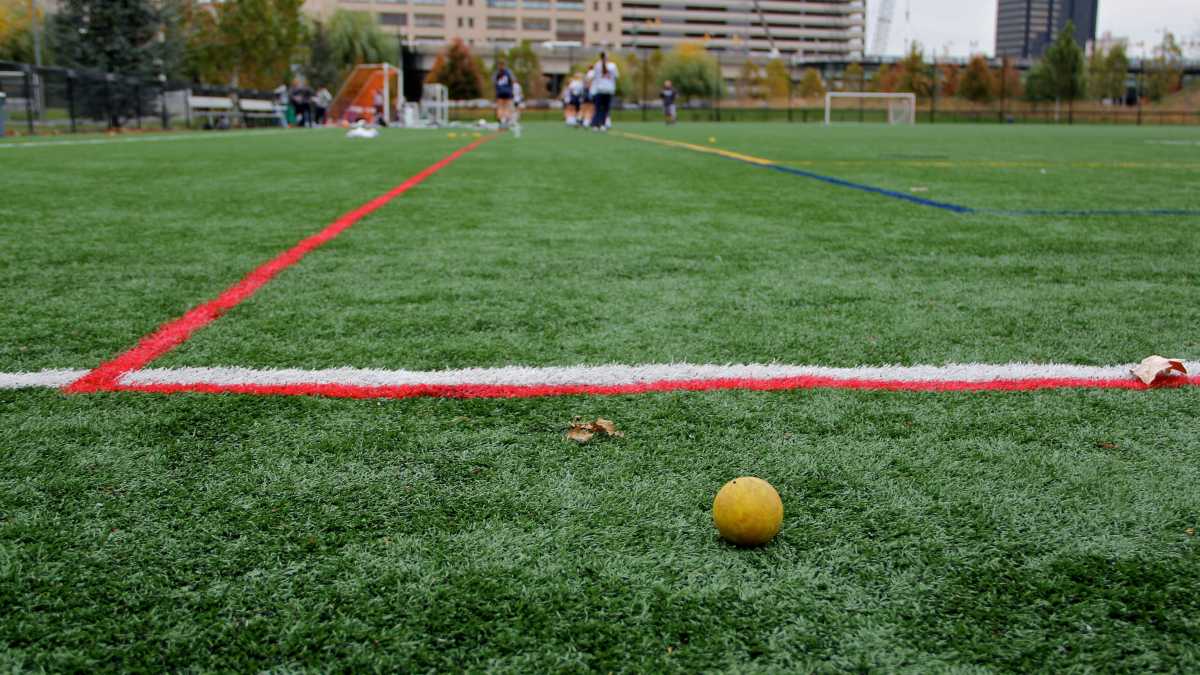As EPA delves into long-term health effects of artificial turf, towns continue field installation
Listen
An artificial turf practice field at the University of Pennsylvania. (Emma Lee / WHYY)
At a recent meeting, Phoenixville Area School District board member Joshua Gould grappled with the question of artificial turf.
“If I knew there absolutely was a health risk, I would spend whatever needed to be spent. But what makes it really difficult is we don’t know,” he said.
Last month, the Environmental Protection Agency announced it was launching a new batch of studies into some of the unknown health effects of playing on artificial turf and some of its composite materials. Without that information, school districts — including Phoenixille’s — and local governments in Pennsylvania, New Jersey and Delaware continue to lay new artificial fields.
Some 8,000 artificial turf baseball diamonds and sports fields already dot the country, according to the Synthetic Turf Council. Many use a material called crumb rubber — made from shredded used car tires and resembling squishy black sand — to cushion the blades of faux “grass.”
In 2014, an investigation by NBC Nightly News put the spotlight on a disturbing trend. Soccer players who spent a lot of time on crumb rubber were being diagnosed with non-Hodgkin lymphoma, a cancer that forms in the lymph nodes. This cluster of the same kind of cancer is unusual and could indicate a common exposure to its cause, according to independent research group Environmental and Human Health, Inc.
Prior to the NBC investigation, some cities had started restricting their use of crumb rubber and artificial turf, calling for more robust investigation of ts composition and hazards.
In the wake of these and other health concerns, as well as pressure from legislators, the EPA announced it would study the effects of long-term exposure to turf. A status report on that new research is expected by the end of 2016.
While new data is being gathered, municipalities in school districts with plans for new fields in place have to decide whether to move forward. Communities around the country are divided on how to treat the potential unknown risks.
Gould and other members of the Phoenixville school board expressed concerns over potential health hazards, and several newly elected members said they disagreed with an earlier board’s decision to approve the fields in the first place.
In the end, there weren’t enough votes to approve a different more expensive infill, or cushioning, material, said school board member Lisa Longo.
“So now we are right back to using the original material, the crumb rubber, that has all of these concerns,” she said.
Studies show that artificial turf fields retain more heat than natural grass, leading to an increased risk of heat-related injuries, and poorly maintained artificial turf fields can lead to a greater risk of concussions.
Phoenixville, in Chester County, joins Gloucester Township in New Jersey and Kent County in Delaware in moving ahead with new artificial sports fields.
Existing studies from the EPA show that very limited exposure to crumb rubber is safe, but they do not address long-term effects. Proponents of the fields say they are easier to maintain, last longer and can be used more regularly than grass fields — even in bad weather.
WHYY is your source for fact-based, in-depth journalism and information. As a nonprofit organization, we rely on financial support from readers like you. Please give today.

